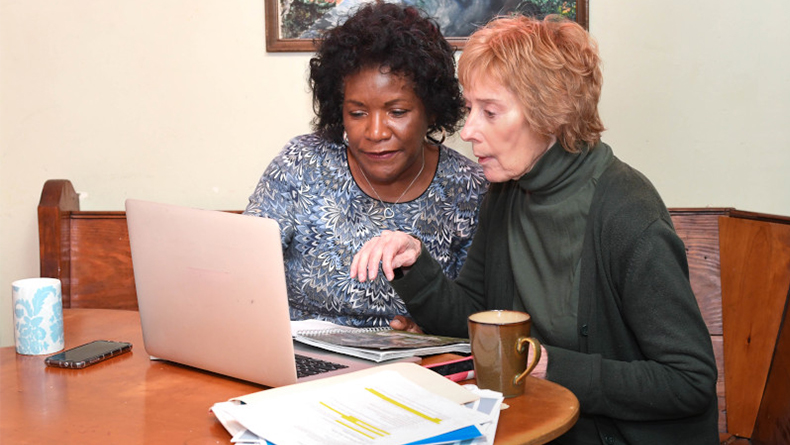AARP Hearing Center
Financial Literacy is a Building Block, not a Panacea for Women’s Inequality
By Bethany Brown, Julie Miller, March 4, 2024 09:53 AM

How can leaders support women to be as resourceful and resilient as ever? International Women’s Day on March 8 and National Financial Literacy Month in April is the moment to understand the role of financial literacy in advancing women’s financial status. What can efforts to build women’s financial literacy accomplish, and in what ways are efforts limited?
Annamaria Lusardi and Olivia Mitchell describe financial literacy as “the knowledge of and ability to use fundamental financial concepts in… economic decision making.” Greater financial literacy gives women better abilities to plan, save, prepare for emergencies and to locate financial products that meet our needs.
Knowing that women in the U.S. have lower rates of financial literacy at all stages of life, regardless of education level or marital status, concerted efforts to build financial literacy among women, including in older adulthood, are critical. The more financial acumen women have, the more we can direct our own financial lives and influence that of others within and across our generations.
The OECD reports that a lack of financial literacy “may have negative consequences not only on individuals’ and households’ future financial well-being, but also on the long-term stability of financial and economic systems.” According to a survey conducted by the National Financial Educators Council, a lack of financial literacy cost Americans more than $388 billion in 2023.
A 2023 AARP report, "How Women 50-Plus Are Driving The Global Longevity Economy," projects that by 2030, women will control 66 percent of America’s wealth, skyrocketing from just 33 percent in 2020. This shift is largely spurred by the Baby Boomer generation’s wealth transfers by inheritance as married women on average outlive older male partners. In this way, older women’s financial literacy will be even more important for the strength of the U.S. economy.
Women’s financial literacy efforts in context
Concerted efforts to improve financial literacy among women of all ages are vital for older women and societies, particularly in countries like the U.S. with large Baby Boom generations. But there are reasons these programs are not a panacea for older women’s financial inequality in the U.S. and around the world.
Older women’s financial inequality happens for many more reasons than simply a lack of financial literacy. Efforts for women’s better financial literacy cannot change that older women live longer, are more likely to be widowed than men, are less likely to remarry, and are more likely to live alone. They cannot change that women are less likely to work in the formal labor market, more likely to work for shorter periods, and for lower wages. Such efforts do not address the absence of financial education before older age, or contributing factors to systemic change for equality in care provision, labor, financial access, and social security (described in in a collaborative report by Research for Impact, The Center for Economic and Social Research, and HelpAge USA). These all exist in addition to taboos about discussing money that work against us, along with harmful social stereotypes.
The shares of labor income accruing to women and men should be equal around the world, yet current female labor income shares range from just 10 percent of total labor income at its lowest to 45 percent at its highest. In wealthy countries that are monitoring poverty in older age, higher rates of poverty among older people compared to rates for middle-aged individuals are due to the greater poverty of older women. One of the reasons this poverty endures is because of gender pension gaps, which are even greater than gender pay gaps in nearly every country in the OECD.
These barriers affect a huge swath of women. Women aged 50 and over are more than 25 percent of the world’s population of women. To really address women’s financial inequality in older age, financial literacy efforts from private and public sectors should complement government efforts to eliminate discrimination across women’s lives, to transition to rights-based social protection systems that lift all older women out of extreme poverty, and to support family caregivers.
Here are examples of policies and practices that could contribute to these efforts:
- Support accessible resources designed for older women to build financial literacy. AARP’s website has some existing general resources through offerings such as the AARP Money Map and insights from AARP’s experts and ambassadors such as HerMoney founder Jean Chatzky.
- Invest in age-inclusive organizations. A 2018 AARP report found that the U.S. economy lost $850 billion in GDP due to age discrimination. One-third of this was directly linked to women’s involuntary retirement. Business leaders can learn about initiatives like AARP’s Living Learning Earning Longer Collaborative, which uses research and industry partnerships to promote age-inclusive workplace practices.
- Invest in support to family caregivers through legislative protections and supports. Business leaders should identify gaps in workplace policies affecting family caregivers.
- Advocate for the participation of 50-plus women in policies that affect them, and design policymaking and legislative efforts for financial equity in ways that are age- and gender-responsive. Policymakers should work to address harmful impacts of age and gender discrimination across all aspects of society.
Collectively, we must support the economic empowerment of women at every age with high-quality work, fair wages, caregiving support, and a secure retirement. As we move toward a future where women will control most of America’s wealth, improving our financial literacy is one important building block for our own security, and the prosperity of the systems in which we live.

































































